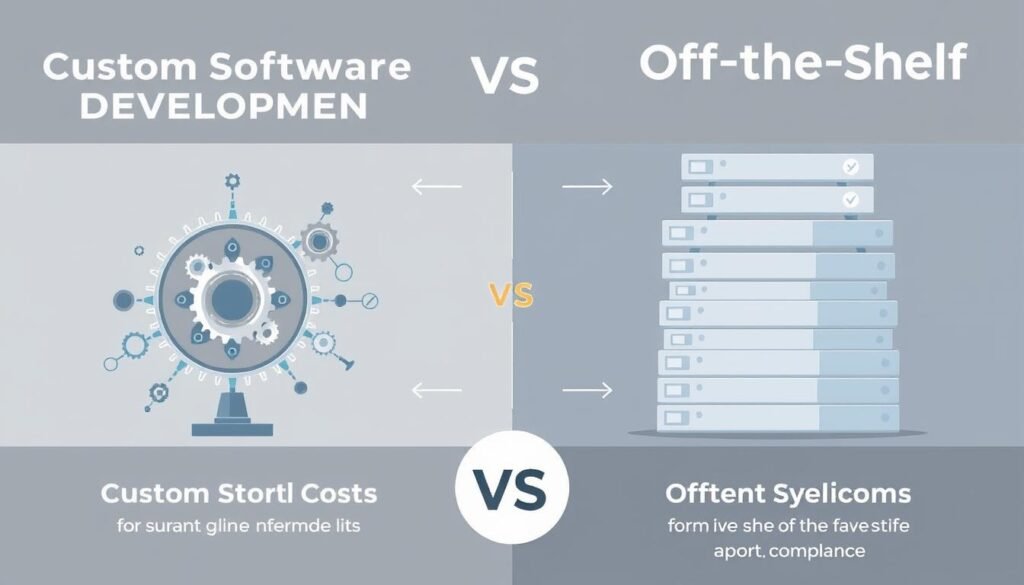Search
People also search for:
Custom Software Development vs Off-the-Shelf Solutions – Which is Right for You?
- Home
- Custom Software Development vs Off-the-Shelf Solutions – Which is Right for You?
Choosing the right business software solutions for your company can be tough. At Consac.dev, we get how important it is to pick wisely. We want to help you find what’s best for your business.
We’re experts in innovative software solutions. We’ll look at the good and bad of custom software development and off-the-shelf options. This will help you decide what’s best for your business.
Need help deciding? Please contact us at info@consac.dev. Our team is ready to help with your digital transformation. We offer software solutions that are made just for you.
Understanding Custom Software Development
In today’s fast-paced world, custom software development is key to innovation and efficiency. Companies need tailored software to stay ahead. This is why bespoke solutions are so important.
Definition and Importance
Custom software development means creating software that fits a company’s unique needs. It’s different from off-the-shelf software because it’s made just for that business. This approach boosts efficiency, improves customer service, and helps businesses grow.
Custom software helps businesses automate and streamline. For example, a company might make a CRM system to manage customer interactions better. Or, they might create a special inventory system to improve their supply chain.
Typical Use Cases
Custom software is used in many areas, including:
- ERP systems tailored to specific business processes
- Custom CRM solutions for better customer engagement
- Bespoke e-commerce platforms for unique shopping experiences
- Industry-specific apps, like healthcare or financial services platforms
These examples show how custom software can meet different business needs.
Key Benefits
Custom software offers many benefits, such as:
- Increased Efficiency: Automating tasks saves money and boosts productivity.
- Improved Customer Experience: Personalized software services make customers happier and more loyal.
- Competitive Advantage: Unique software features set a business apart from competitors.
- Scalability: Custom software grows with the business, adapting to new needs and growth.
For those thinking about custom software, finding a good software development company is key. They can help bring your ideas to life. This way, you can fully benefit from custom software and move your business forward.
What Is Off-the-Shelf Software?

In today’s fast-paced world, off-the-shelf software is a quick and easy way to meet business goals. It’s software that’s already made and can be used by many people. This means you don’t have to spend time and money on custom development.
Definition and Characteristics
Off-the-shelf software is easy to find, simple to use, and affordable. It’s made for lots of users, so it can fit many business needs. Key characteristics include:
- Pre-developed and readily available
- Designed for a wide range of users
- Cost-effective compared to custom solutions
- Easy to implement and integrate
Common Examples
Examples of off-the-shelf software include Microsoft Office, Salesforce, and SAP. These tools are used in many industries because they are reliable and work well.
Advantages of Off-the-Shelf Solutions
Off-the-shelf software has many benefits. It’s immediately available, so you can quickly solve your software needs. It’s also cost-effective, saving you money compared to custom development. For the best advice on using off-the-shelf software, talk to a software consulting firm.
Understanding off-the-shelf software helps businesses make smart choices. It can boost productivity and make operations smoother. Off-the-shelf solutions are a good option for companies looking to be more efficient and effective.
Custom Software Development: Pros and Cons

In the world of digital change, custom software is a special solution for businesses. It’s important to know the good and bad sides of custom software development.
Advantages Worth Considering
Custom software has many benefits. It gives a tailored solution that fits your business perfectly, making things more efficient. It also gives you a competitive edge with unique features that others don’t have.
It makes it easy to work with your current systems, saving money and effort. Custom software lets your business scale and adapt quickly to new situations. This is key in today’s fast business world, where being able to change and innovate fast is important.
Potential Drawbacks
But, custom software also has its challenges. One big issue is the higher upfront cost. This can be a problem for small and medium-sized businesses with tight budgets.
Another big problem is the longer development time. Making custom software takes a lot of steps, from planning to testing. This means it takes longer to get the software ready, which might not work for businesses that need things fast.
Time and Cost Factors
The time and cost of custom software depend on several things. These include how complex the project is, the technology used, and the team’s experience. Businesses need to think about these to estimate the total cost of ownership and if it’s worth it.
It’s also important to think about the ongoing maintenance and support costs. Custom software needs updates and care to stay useful and safe. This ongoing cost should be part of your cost-benefit analysis.
Off-the-Shelf Software: Pros and Cons

Off-the-shelf software is a common choice for businesses. It’s quick to use and affordable. But, it also has its own set of challenges. Understanding the pros and cons helps businesses decide if it fits their needs and goals.
Key Benefits
One big plus of off-the-shelf software is its rapid deployment. It’s ready to go, so businesses can start using it fast. This saves time and money. Plus, it’s often cheaper than making custom software because many people use it.
- Wide Availability: There are many vendors with different software options for businesses.
- Established Support: These products have good support, like help guides and customer support teams.
- Proven Track Record: Many have been tested and used by lots of businesses.
Limitations to Keep in Mind
Off-the-shelf software has its downsides too. One big issue is limited customization. It might not fit your business perfectly. Also, it can have compatibility issues with your current systems.
- Limited Flexibility: It might not change to fit your unique business needs.
- Security Risks: Popular software can be a target for hackers.
- Dependence on Vendor: You rely on the vendor for updates and support, which can be a problem if they’re not good.
For a full picture of off-the-shelf software, talk to a software development firm. They can help you decide if it’s right for your business. By looking at both sides, you can make a smart choice.
Determining Your Business Needs

Figuring out what your business needs is the first step in choosing software. You must know what you need to do, how much you can spend, and how your business will grow. This helps you decide between custom-made software and ready-made products.
Analyzing Your Requirements
Start by looking closely at how your business works. Find out where things could be better, like inefficiencies in workflow, data management challenges, or customer service enhancements. Talk to people from different parts of your company to learn what they need and what’s hard for them.
- Make a list of the main things you want your software to do.
- Think about how much data you’ll handle.
- Figure out how much you need to change the software.
Budget Considerations
Money is a big part of your choice. Custom software might cost more at first but could save money in the long run. It can make things more efficient and cut down on mistakes. Ready-made software is cheaper to start but might cost more over time for updates and support.
When looking at your budget, think about:
- The cost of starting or buying the software.
- What you’ll spend on keeping it running and supported.
- Any extra costs for making it your own or upgrading it.
Future Scalability
Your software should grow with your business. Think about if your needs will change soon and if the software can change with you. Custom software can be made to grow, but ready-made software might not be as flexible.
“The best way to predict the future is to create it.” – Abraham Lincoln
This quote shows why planning for the future is key when picking software.
If you need help figuring out your business needs and picking the right software, talk to a software consulting firm. They can give you advice that fits your business, helping you choose the best solution for your goals.
Comparing Cost: Custom vs. Off-the-Shelf

It’s important to know the cost difference between custom and off-the-shelf software. This choice affects both your initial and ongoing expenses. It’s key to understand these costs to make the right choice for your business.
Initial Investment
Custom software development costs more at first than off-the-shelf options. This is because it’s made just for you, which takes more time and money. A Gartner report says custom software can cost between $50,000 and over $1 million. This depends on how complex and big the project is.
Off-the-shelf software is cheaper to start with. You can buy or subscribe to it for a set price. But, you might spend more later to make it fit your needs.
Long-Term Costs
Custom software might cost more at first, but it can save money in the long run. It’s made just for you, so it works better and might not need extra software. A software expert says, “custom software is built to meet specific business needs, it can streamline processes and improve efficiency”.
Off-the-shelf software, though, can cost more over time. You’ll pay for subscriptions, upgrades, and extra licenses as your business grows. A Forrester study found that off-the-shelf software can be hard to scale, leading to higher costs later on.
Talking to a software development company can help you understand the costs. They can compare custom and off-the-shelf options for you. This way, you can choose what fits your budget and goals best.
Speed of Implementation: Custom vs Off-the-Shelf

The speed of implementation is key for businesses choosing between custom and off-the-shelf software. In today’s fast world, being quick to adapt is a big plus. It can give you a competitive edge.
Looking at custom software solutions, the time it takes to develop is important. Custom software is made just for your business. This means it takes longer to make.
Development Timeframes
Custom software goes through many stages. These include planning, design, development, testing, and deployment. It can take from a few months to over a year, depending on the project’s complexity.
- Planning and analysis phase: 2-4 weeks
- Design phase: 2-6 weeks
- Development phase: 3-9 months
- Testing and quality assurance: 1-3 months
- Deployment: 1-2 weeks
On the other hand, off-the-shelf software is ready to use right away. It needs minimal setup.
Immediate Availability
Off-the-shelf software is ready for download or installation. This lets businesses start using it quickly. It’s great for solving immediate problems or needs.
| Implementation Aspect | Custom Software | Off-the-Shelf Software |
|---|---|---|
| Development Time | Several months to a year or more | Immediate availability |
| Setup and Configuration | Complex, tailored setup | Minimal setup required |
| Cost Implication | Higher upfront costs | Lower initial costs, possible additional fees |
For businesses going through digital transformation, knowing how fast software can be implemented is vital. Custom software fits your business well but takes longer. Off-the-shelf software is quicker but might not fit as perfectly.
Integration with Existing Systems

Seamless integration is key to making software work well in your organization. We’ll look at how custom and off-the-shelf software fit with your systems. It’s important to see how each fits with what you already have.
Custom Software Integration
Custom software is made to work with your systems. It’s designed to fit perfectly, avoiding problems and improving how everything works together.
Custom software integration has many benefits:
- It makes different systems work better together
- It helps share data smoothly
- It’s flexible and can change with your business
Off-the-Shelf Software Compatibility
Off-the-shelf software is easy to use but might not fit with your systems. But, many are made to work well with others. They have standard ways to connect and share data.
To integrate off-the-shelf software well, consider these steps:
- Check if it works with your systems
- Look at the integration tools and APIs it offers
- Think about customizing it for better fit
For help with software integration, talk to a software consulting services firm. They can help solve integration problems and improve your software setup.
| Integration Aspect | Custom Software | Off-the-Shelf Software |
|---|---|---|
| Integration Approach | Bespoke integration solutions tailored to existing infrastructure | Standardized integration protocols and APIs |
| Compatibility | Highly compatible due to customized design | Generally compatible, but may require additional configuration |
| Flexibility | High flexibility to adapt to changing business needs | Moderate flexibility, with limitations based on the software’s design |
Knowing how custom and off-the-shelf software integrate helps you choose the right one. This choice should match your business goals and technical setup.
Evaluating Scalability & Adaptability

In today’s fast-paced business world, software must adapt and scale quickly. As businesses grow, their software needs to keep up. It must handle more demands and new challenges.
Tailoring Custom Solutions
Custom software is made for a business’s specific needs. It’s flexible, making it easy to change as the business grows. This way, the software can add new features and capabilities as needed.
Key benefits of custom software scalability include:
- Ability to handle increased user demands or data volume
- Ease of integrating new features or modules
- Flexibility to adapt to changing business processes
| Scalability Features | Custom Software | Off-the-Shelf Software |
|---|---|---|
| Handling Increased Demand | Highly adaptable | Limited by design |
| Integration of New Features | Easily integrated | Dependent on vendor updates |
| Adaptability to Change | Highly flexible | Limited flexibility |
Flexibility of Off-the-Shelf Options
Off-the-shelf software can also scale and adapt, though not as much as custom solutions. Many commercial packages are designed for various business needs. They may offer customization or modular designs that can be adjusted.
But, the flexibility of off-the-shelf software is generally limited by its generic design. Businesses might find it hard to adapt to future needs without big changes or costs.
The choice between custom and off-the-shelf software depends on a business’s needs, growth, and budget. By looking at scalability and adaptability, businesses can choose wisely for their success.
Security Considerations
Businesses face many challenges in the software world, and security is a big one. It’s important to keep software safe, whether it’s custom-made or off-the-shelf.
Custom Software Security Benefits
Custom software has big security pluses. It’s made just for a business, so it can be built with safety in mind. This lets developers spot and fix problems early on.
Key security advantages of custom software include:
- Less chance of common problems found in widely used software.
- It can have strong security features that fit the business’s needs.
- More control over how data is kept safe and who can see it.
Off-the-Shelf Software Risks
Off-the-shelf software is easy to use and can save money. But, it also has security risks. It’s often targeted by hackers because it’s so common.
Some of the security risks associated with off-the-shelf software include:
- Having to wait for the vendor to fix security issues.
- Higher risk of data breaches because of known problems.
- Not being able to customize it enough to meet all security needs.
For help making your software safe, talk to a software development company. They should know a lot about making custom software that’s secure.
Making the Right Decision for Your Business
Choosing the right software is key to your business’s success. Both custom and off-the-shelf solutions have their pros and cons. It’s important to understand these differences.
Key Considerations
Think about your business needs, budget, and growth plans. Custom software is made just for you, helping your business grow. On the other hand, off-the-shelf software is ready to use and can save money.
Expert Guidance
Need help picking the right software? Talking to software experts can be a big help. They can guide you through the options and find the best fit for your business.
For personalized advice on choosing the right software, contact us at info@consac.dev. We’re ready to assist you in making a choice that will move your business forward.

